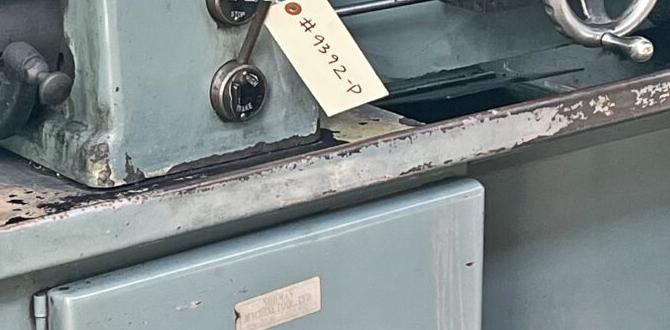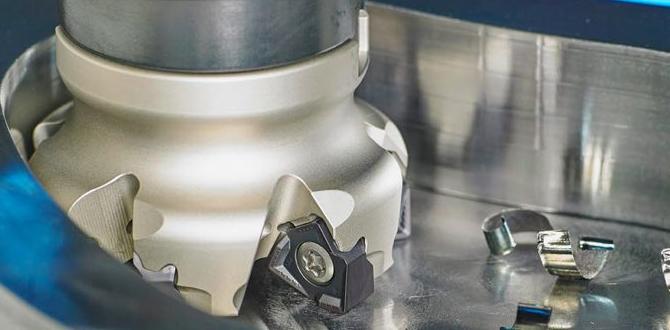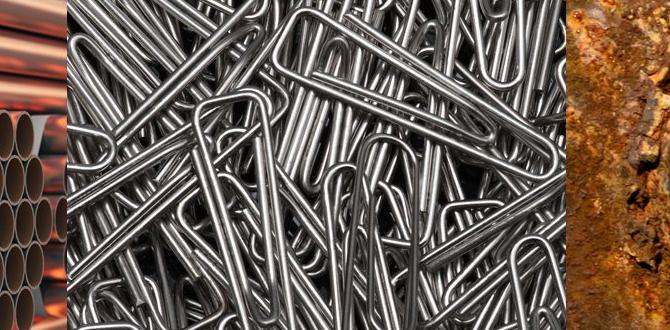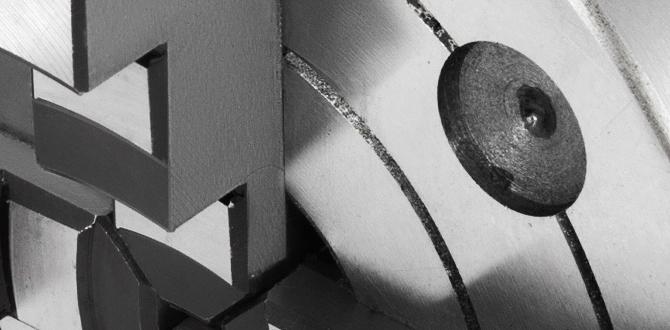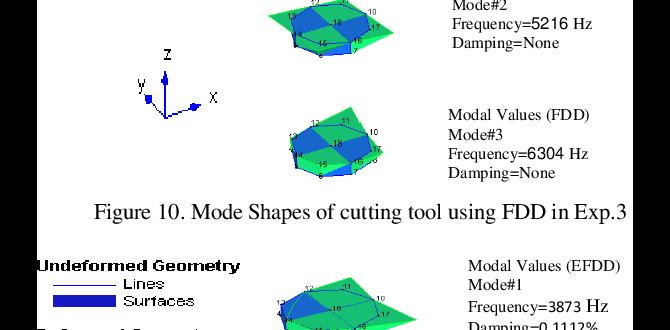Need a faster lathe? Upgrading your lathe motor can be the key to better material removal, smoother finishes, and tackling tougher projects. This guide explains how to choose and install the right motor to give your lathe the power boost it needs for increased efficiency and capability.
Lathes are amazing tools for shaping wood and metal, but sometimes, they just don’t feel powerful enough. You might notice the motor struggling when cutting thicker material, or perhaps you want to achieve finer finishes that require more consistent speed. It can be frustrating when your lathe limits your creative potential. Don’t worry, upgrading your lathe’s motor is often an achievable project that can dramatically improve its performance. This guide will walk you through everything you need to know, from understanding motor types to safely installing a new one, so you can get back to making chips fly.
Why Upgrade Your Lathe Motor? The Power Behind the Performance
The motor is the heart of your lathe. It’s the component that provides the rotational force, or torque, needed to spin your workpiece against cutting tools. A weak or inefficient motor can lead to a host of problems, making your work harder and the final results less impressive. Understanding why you might need more power is the first step to finding the right solution.
Think of it like this: if you’re trying to push a heavy box across a floor, you need strength. If the box is really heavy, a weak push won’t get you very far, and you might even get stuck. Your lathe motor is similar. When you’re turning a large piece of dense wood or trying to take a substantial cut on a piece of metal, the motor has to work hard. A motor not suited for the task will bog down, slow its rotation, or even stall. This not only stops your progress but can also lead to a rough finish and potentially unsafe conditions.
Several signs might tell you it’s time for a motor upgrade:
- Bogging Down: The motor slows considerably or stops when you apply a cutting tool to the wood or metal, especially on larger or harder materials.
- Stalling: The motor completely stops spinning during a cut. This is a common sign of insufficient torque.
- Slow Spindle Speeds: Even at its highest setting, the lathe doesn’t spin as fast as you’d like for certain operations, like fine finishing or high-speed metal cutting.
- Overheating: The motor gets excessively hot during normal operation, indicating it’s working too hard or isn’t efficient.
- Desire for More Capability: You want to turn larger diameter workpieces or tackle more demanding tasks that require a higher power output.
- Old or Damaged Motor: The existing motor is showing signs of wear, making unusual noises, or is simply past its prime.
A more powerful motor means your lathe can handle a wider range of projects, remove material more efficiently, and maintain consistent speeds for smoother finishes. It opens up new possibilities for your workshop.
Understanding Lathe Motors: Types and Key Specs
Before you go shopping for a new motor, it’s important to understand the basics of what makes a motor tick and what specifications are crucial for your lathe. Not all motors are created equal, and picking the right one will ensure compatibility and optimal performance. We’ll focus on the most common types you’ll encounter for DIY and workshop lathes.
Common Motor Types for Lathes
For most home workshop and DIY lathes, you’ll encounter two primary types of electric motors:
- Universal Motors: These are very common in smaller, less expensive woodworking lathes. They are known for their high starting torque and ability to run on both AC and DC power (though you’ll typically only use AC in your workshop). They can achieve high RPMs and are often variable speed with a simple dial. The downside is they can be noisy, generate heat, and wear out brushes, requiring periodic replacement.
- Induction Motors: These are the workhorses found in most metalworking lathes and many larger woodworking lathes. They are generally more durable, quieter, and require less maintenance than universal motors. Induction motors are designed to run on AC power and are very robust. Variable speed functionality is often achieved through a Variable Frequency Drive (VFD), which also offers excellent control and efficiency.
Essential Motor Specifications to Consider
When looking at a replacement motor, pay close attention to these key specifications:
Horsepower (HP)
This is a measure of the motor’s power output. For lathes, higher horsepower generally means more torque and the ability to handle heavier loads and take deeper cuts. Common sizes for woodworking lathes range from 1/2 HP to 2 HP, while metal lathes might use motors with similar or higher ratings depending on their size and intended use. Always consider the maximum HP your lathe’s frame and drive system can safely handle.
RPM (Revolutions Per Minute)
This indicates how fast the motor shaft spins. Lathes often use different pulley combinations to achieve a range of spindle speeds. A motor with a higher base RPM might offer more flexibility in achieving high spindle speeds for fine finishing. For example, a 1750 RPM motor is common, but you might see 3450 RPM motors on some machines.
Torque
Torque is the rotational force the motor produces. It’s arguably more important than horsepower for many lathe operations, especially when removing material. A motor with high torque can maintain its speed under load, preventing the bogging down mentioned earlier. While horsepower is a direct measure of power output, torque is what gives your lathe the “grunt” to cut effectively. Torque is often not directly listed on motor nameplates but is related to horsepower and speed.
Voltage (V) and Amperage (A)
Ensure the motor’s voltage matches your workshop’s electrical supply (e.g., 120V or 240V). The amperage indicates the current the motor draws. You need to ensure your circuit breaker and wiring can handle the amperage draw of the new motor, especially when it starts up (inrush current).
Frame Size / Mounting
Motors come in standardized frame sizes (e.g., NEMA frames in North America). This dictates the physical dimensions of the motor and how it mounts to your lathe’s base or motor mount. You’ll need to measure your existing motor’s mounting bolt pattern, shaft diameter, and overall dimensions to find a compatible replacement.
Enclosure Type
For a typical workshop, an Open Drip-Proof (ODP) enclosure is common. This allows air to flow through the motor for cooling but protects it from falling debris or drips. Totally Enclosed Fan-Cooled (TEFC) motors offer better protection against dust and moisture.
Choosing the Right Motor: Matching Your Needs
Selecting the correct motor involves balancing your lathe’s capabilities with your project requirements. A common upgrade path for a hobbyist woodworking lathe might be moving from a 1/2 HP motor to a 1 HP or 3/4 HP motor. For metalworking, you might be looking at higher HP and torque ratings.
Consider your typical projects. If you mainly turn small, soft woods for bowls, a basic motor might suffice. But if you plan to turn large, dense hardwoods, segment bowls, or undertake metal turning projects, a more robust motor is essential. Always err on the side of slightly more power if your lathe can handle it.
How to Safely Install a New Lathe Motor: A Step-by-Step Guide
Upgrading your lathe’s motor is a rewarding project that can enhance your machine’s capabilities significantly. However, it involves working with electrical components and heavy parts, so safety is paramount. Follow these steps carefully, and don’t hesitate to consult your lathe’s manual or a qualified electrician if you’re unsure about any part of the process.
Step 1: Safety First! Preparation and Disconnection
Before you even think about touching a wrench or screwdriver, ensure the lathe is completely de-energized. This is the most critical step to prevent electric shock or injury.
- Unplug the Lathe: Make sure the power cord is unplugged from the wall outlet.
- Lockout/Tagout (if applicable): In a professional setting, you would use lockout/tagout procedures to ensure power cannot be accidentally restored. For a home shop, unplugging is usually sufficient, but always double-check.
- Clear the Work Area: Remove any debris, tools, or materials from around the lathe to give yourself ample space to work safely.
- Gather Your Tools and New Motor: Have all necessary tools (wrenches, screwdrivers, wire strippers, crimpers, multimeter, etc.) and your new motor ready.
Step 2: Removing the Old Motor
Once power is confirmed off, you can proceed with removing the old motor. The exact process may vary slightly depending on your lathe model, but the general steps are similar.
- Access the Motor: You may need to remove a motor cover, access panel, or a portion of the lathe’s base to reach the motor and its wiring.
- Document Wiring: Before disconnecting any wires, take clear photos with your phone from multiple angles or draw a diagram of how the wires are connected to the motor terminals. This will be invaluable when connecting the new motor.
- Disconnect Wiring: Carefully disconnect the wires from the old motor. Note any wire nuts, terminal screws, or connectors. If there are splices, you might need to cut wires and plan to re-splice them later.
- Detach the Motor Mount: Loosen and remove the bolts or nuts that secure the motor to its mounting bracket or the lathe’s frame.
- Support the Motor: Motors can be heavy. Be prepared to support the motor as you remove the last mounting bolts to prevent it from falling.
- Remove the Old Motor: Carefully lift or slide the old motor away from the lathe.
Step 3: Preparing the New Motor and Mount
Now, it’s time to prepare your new motor and its mounting. If you’re fortunate, the new motor will have the same mounting pattern and shaft diameter as the old one, simplifying installation. If not, you may need adapters or modifications, which can be more complex.
- Verify Fitment: Compare the mounting bolt pattern, Shaft diameter, and shaft length of the new motor with the old one. Check that it physically fits in the designated space.
- Clean Mounting Surfaces: Ensure the mounting surfaces on the lathe frame and the new motor are clean and free of dirt, grease, or old gasket material.
- Install Motor Mounts (if applicable): If your lathe uses adjustable motor mounts for belt tensioning, ensure they are set up correctly for the initial motor installation.
Step 4: Mounting the New Motor
With the old motor out and the new one ready, you can install it. Proper alignment is crucial, especially if you’re using belts and pulleys.
- Position the Motor: Carefully place the new motor onto the mounting bracket or frame.
- Install Mounting Bolts: Insert and loosely tighten the mounting bolts.
- Align Pulleys: If your lathe uses belts and pulleys, align the pulley on the new motor shaft precisely with the pulley on the lathe spindle or countershaft. Misalignment can cause premature belt wear and vibration. You can use a straight edge or laser alignment tool for accuracy.
- Tighten Mounting Bolts: Once aligned, securely tighten the motor mounting bolts.
Step 5: Wiring the New Motor
This is where your preparation (photos/diagrams) and understanding of electrical connections become vital. If working with AC power, it’s generally straightforward, but always proceed with caution.
- Consult Motor Diagram: Refer to the wiring diagram provided with your new motor. This will show the connections for power (Line 1, Line 2 or Hot, Neutral) and ground.
- Secure Connections: Connect the wires from your lathe’s power system to the corresponding terminals on the new motor. Use appropriate connectors (like wire nuts or crimp connectors) and ensure all connections are secure and insulated.
- Grounding: Crucially, ensure the motor is properly grounded to the lathe’s frame to prevent electrical shock hazards. Locate the ground terminal (usually marked with a ground symbol) on the motor and connect it to a grounding point on the lathe frame.
- Double-Check Wiring: Compare your connections against your photos/diagram and the motor’s wiring diagram one last time. Ensure no stray wire strands are exposed.
Step 6: Belt Installation and Tensioning
Once the motor is mounted and wired, you can install the drive belt.
- Install the Belt: Place the belt onto the motor pulley and the corresponding pulley on the lathe.
- Tension the Belt: Adjust the motor mount (if adjustable) or use a tensioning mechanism to achieve the correct belt tension. The belt should be snug enough to grip without slipping but not so tight that it puts excessive strain on the motor bearings or lathe components. A good rule of thumb is to have about 1/2 inch of deflection when pressed in with moderate finger pressure.
Step 7: Testing and Final Checks
Now for the moment of truth. Make sure everything is safe to test.
- Clear the Area Again: Ensure no tools or hands are near moving parts.
- Reconnect Power: Plug the lathe back into the power outlet.
- Initial Test Run: Turn on the lathe and listen for any unusual noises. Check that the motor spins smoothly.
- Test Under Load: Briefly try a very light cut on a piece of scrap material to ensure the motor is performing as expected and has adequate power.
- Check for Vibrations/Heat: Run the lathe for a few minutes and monitor for excessive vibration or overheating of the motor.
- Reinstall Covers: Once you are satisfied with the operation, reattach any motor covers or access panels that you removed.
If at any point you encounter issues, immediately turn off the power and re-evaluate your work. Electrical work can be hazardous, so if you’re uncertain, seek professional help.
Selecting the Right Motor: A Comparative Table
Choosing between different motor options can be daunting. This table breaks down common motor characteristics to help you make an informed decision for your lathe upgrade.
| Motor Type | Typical Applications | Pros | Cons | Ideal Use Case for Lathe Upgrade |
|---|---|---|---|---|
| Universal Motor | Smaller woodworking lathes, portable tools | High starting torque, readily available, compact size, can be variable speed | Noisy, require brush maintenance/replacement, can generate significant heat, lower lifespan | Budget-friendly upgrade for smaller woodworking lathes where space is limited and high power isn’t the primary concern. |
| AC Induction Motor (Single Phase) | Mid-size to large woodworking lathes, small metal lathes | Durable, reliable, quiet, low maintenance, good power range | Requires a capacitor for starting; variable speed often needs a VFD; lower starting torque than universal | Excellent all-around choice for most general-purpose woodworking and metalworking lathes, especially when paired with a VFD for speed control. |
| AC Induction Motor (Three Phase) | Larger metalworking lathes, industrial machinery | High torque, very durable, efficient, smooth operation | Requires three-phase power (often needs a phase converter for home shops); more expensive | Best for demanding metalworking applications or when converting a legacy machine to professional-grade performance, assuming three-phase power is available or can be generated. |
Motor Upgrades for Enhanced Lathe Performance
Let’s look at typical upgrade scenarios:
- From 1/2 HP to 1 HP: This is a common and noticeable upgrade for many entry-level woodworking lathes. You’ll gain significant torque, allowing for deeper cuts, turning larger workpieces, and working with harder woods more comfortably.
- From 1 HP to 2 HP: For serious woodturners working with large bowls, platters, or dense hardwoods, this offers even more power reserves.
- Adding a VFD to an AC Induction Motor: This is arguably the most impactful upgrade for many lathes. A Variable Frequency Drive (VFD) allows precise speed control from very slow to very fast, often with soft-start capabilities, and effectively increases torque at lower speeds. It provides a professional level of control and performance. You can learn more about VFDs and their benefits from resources like U.S. Department of Energy’s Energy 101: Variable Speed Drives.
When upgrading, it’s essential to confirm that your lathe’s bed, spindle bearings, and overall construction can handle the increased power and torque. A motor that’s too powerful for the machine’s frame can lead to excessive vibration and premature wear.
Common Lathe Motor Issues and Troubleshooting
Even with a new motor, issues can arise. Here’s a quick guide to common problems and how

